“I2C overview”的版本间的差异
| 第263行: | 第263行: | ||
==How to trace and debug the framework == | ==How to trace and debug the framework == | ||
| − | + | 在 Linux<sup>®</sup> 内核中,有调试和监视I2C的标准方法。调试可以在不同的级别进行:硬件和软件。 | |
===How to trace=== | ===How to trace=== | ||
====Dynamic trace==== | ====Dynamic trace==== | ||
| − | + | 此处提供了详细的动态跟踪 [[How to use the kernel dynamic debug]]<br/> | |
{{Board$}} echo "file i2c-* +p" > /sys/kernel/debug/dynamic_debug/control | {{Board$}} echo "file i2c-* +p" > /sys/kernel/debug/dynamic_debug/control | ||
| − | + | 此命令在运行时启用与I2C内核和驱动程序有关的所有跟踪。<br/><br/> | |
| − | + | 尽管如此,在 [[Menuconfig or how to configure kernel | Linux® Kernel menu configuration]] 级,它提供了调试的粒度:核心和/或总线。<br/> | |
Device Drivers -> | Device Drivers -> | ||
[*] I2C support -> | [*] I2C support -> | ||
2020年11月6日 (五) 17:42的版本
本文提供有关I2C系统以及如何插入I2C STM32驱动程序的基本信息。
目录
Framework purpose
本文旨在解释如何更准确地使用I2C:
- 如何在 Linux® BSP 上激活I2C接口
- 如何从内核空间访问I2C
- 如何从用户空间访问I2C。
本文介绍了在master 和 slave模式下的 Linux® I2C[1]接口。
通过该外部资源,提出了I2C[2] 的简介。
有关 slave 接口的说明,请参见slave-interface[3].
System overview
I2C 是“ IC间总线”的缩写,“ Inter-IC”总线是一种简单的总线协议,广泛用于低数据速率通信就足够了。
I2C是微处理器 I2C 外围设备接口的缩写。
在微处理器设备周围,用户可以添加许多 I2C 外部设备来创建定制板。 可以通过I2C从用户空间或内核空间访问每个外部设备。
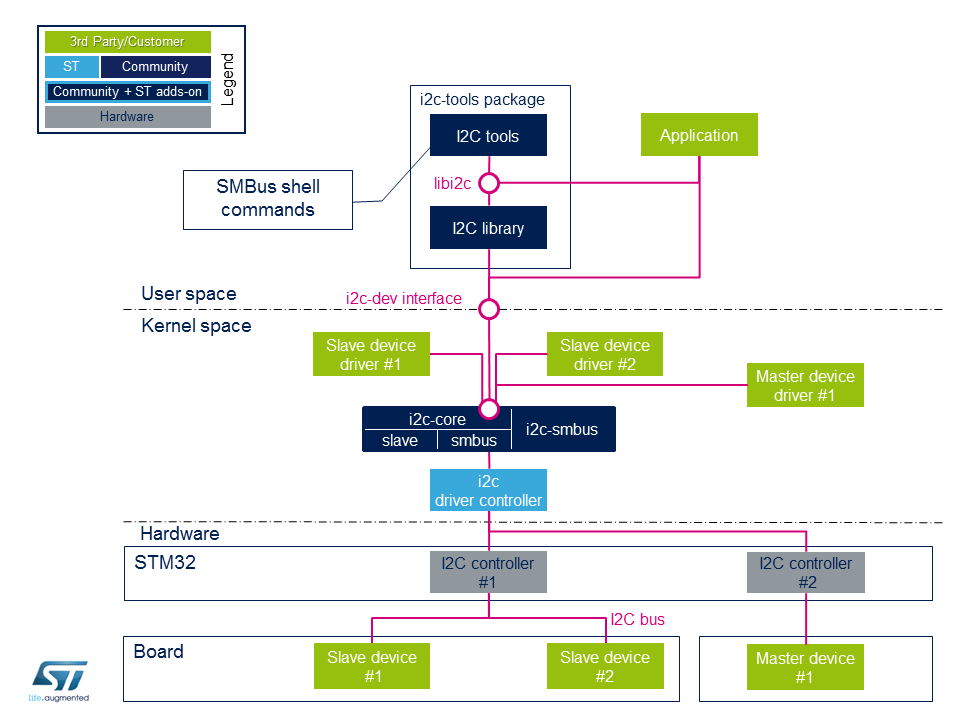
Component description
Board external I2C devices
- 从设备X是相对于STM32表现为从设备的物理设备(通过 I2C 总线连接到STM32)。
STM32仍是 I2C 总线上的主机。
- 主设备X是相对于STM32充当主设备的物理设备 (通过 I2C 总线连接到STM32) 。
在这种情况下,STM32充当 I2C 总线上的从设备。
STM32 I2C internal peripheral controller
它对应于STM32 I2C适配器,该适配器处理与同一总线上连接的任何外部设备的通信。
它管理从设备(如果有的话),并且如果连接了外部主设备,则可以充当从设备。
STM32微处理器设备通常嵌入 I2C internal peripheral 的多个实例,以管理多个I2C总线。 提供了一个驱动程序,用于控制硬件。
i2c-stm32
内部STM32 I2C控制器驱动程序向基于i2c-core-base的ST I2C内部外围控制器抽象层提供了支持。
它定义了I2C核心基础要使用的所有I2C传输方法算法,其中包括I2C和SMBus[4] 传输API ,注册/注销从属API和功能检查。
即使I2C Core可以在整个标准I2C消息中模拟SMBus协议,所有SMBus功能都在驱动程序中实现。
i2c-core
这是通信的大脑:它实例化和管理所有总线和外围设备。
- 如其名称所述,为i2c-core ,它是I2C核心引擎,但它也负责解析适配器和/或设备的设备树条目
- i2c-core-smbus处理所有与SMBus相关的API。
- i2c-core-slave 管理充当STM32中的从设备的I2C设备。
- i2c-smbus处理特定的协议SMBus警报。 (由I2C核心库处理的SMBus主机通知)
Board peripheral drivers
该层表示与物理外围设备关联的所有驱动程序。
外围设备驱动程序可以编译为内核模块,也可以直接编译为内核(也称为内置).
i2c-dev
i2c-dev是用户与外围设备之间的接口。 它是一个内核驱动程序,它使用此dev-interface API提供对用户空间应用程序的I2C总线访问。 请参见示例API Description.
i2c-tools
I2C Tools软件包提供了:
- shell命令通过i2c-dev通过SMBus协议访问I2C
- library 将SMBus函数用于用户空间应用程序,所有这些函数都在这个SMBus协议API中进行了描述。
Note : 某些外围设备无需SMBus协议即可工作。
API description
libi2c
I2C工具[5] 软件包提供了一组Shell命令,这些命令主要使用SMBus协议访问I2C和API, 开发一个应用程序(libi2c)。
所有工具和libi2c均依赖SMBus API,但 i2ctransfer不是,因为它依赖于标准I2C协议。
工具和libi2c通过devfs读/写/ ioctl调用访问SMBus和I2C API。
SMBus协议构成 I2C 规范中定义的数据传输格式的子集。
SMBus规范中定义的标准方法无法访问不符合这些协议的I2C外设。
有关 I2C[6] 和SMBus协议[7]的更多详细信息,请参见外部参考。
libi2c API模拟“SMBus协议”[7] ,但在用户空间级别。
此库中的API与 SMBus protocol[7]中的API相同。除了特定的SMBus协议API(例如SMBus Host Notify和SMBus Alert)外,所有SMBus API均在此处重复。
User space application
User space application 正在使用内核驱动程序(i2c-dev),该驱动程序通过devfs提供I2C访问。
支持的系统调用: open(), close(), read(), write(), ioctl(), llseek(), release().
| Constant | Description |
|---|---|
| I2C_SLAVE/I2C_SLAVE_FORCE | Sets slave address for read/write operations |
| I2C_FUNCS | Gets bus functionalities |
| I2C_TENBIT | 10bits address support |
| I2C_RDWR | Combined R/W transfer (one STOP only) |
| I2C_SMBUS | Perform an SMBus transfer instead of standard I2C |
以上命令是主要命令(框架中定义了更多命令): 请参见dev-interface API[8] 获取完整列表。
Kernel space peripheral driver
Kernel space peripheral driver 同时访问 I2C 和SMBus设备,并使用以下 I2C核心API[9]
Configuration
Kernel configuration
使用Linux Menuconfig工具在内核配置中激活I2C: Menuconfig or how to configure kernel.
[x] Device Drivers
[x] I2C support
[x] I2C device interface
[ ] I2C Hardware Bus support
[x] STMicroelectronics STM32F7 I2C support
这可以在您的内核中手动完成:
CONFIG_I2C=y CONFIG_I2C_CHARDEV=y CONFIG_I2C_STM32F7=y
如果软件需要SMBus特定协议,例如SMBus Alert协议和SMBus Host Notify协议,则添加:
[x] Device Drivers
[x] I2C support
[x] I2C device interface
[ ] Autoselect pertinent helper modules
[x] SMBus-specific protocols
[ ] I2C Hardware Bus support
[x] STMicroelectronics STM32F7 I2C support
这可以在您的内核中手动完成:
CONFIG_I2C_SMBUS=y
Device tree configuration
How to use the framework
本节介绍如何使用框架访问I2C外设。
i2c-tools package
在用户空间中将 I2C Tools 与基于SMBus API协议[7] 的shell命令配合使用,可以轻松快速地访问I2C,而无需编写任何代码。
用例 许多外壳命令允许检测I2C总线并通过SMBus协议访问I2C外设。 该软件包包括一个库,以便在C程序中使用SMBus协议。
有关详细说明,请访问 link。
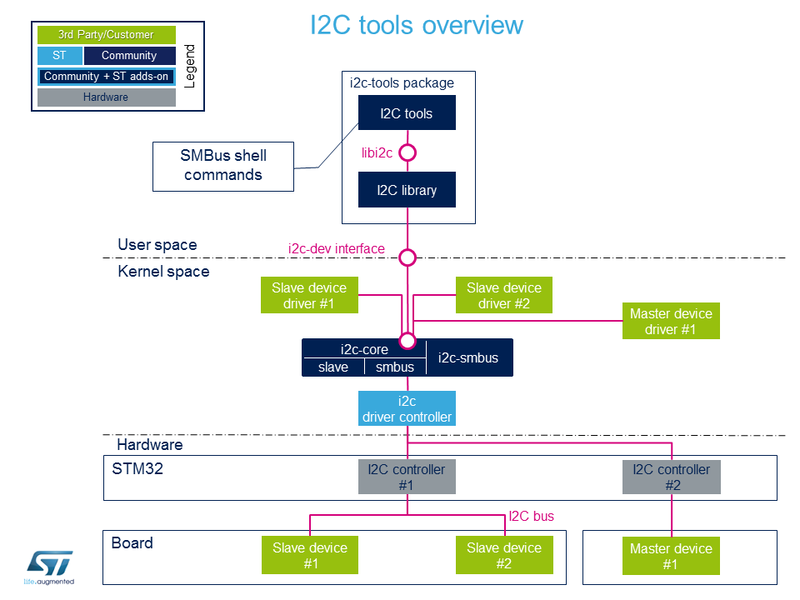
User space application
允许在用户空间中使用带有此 device interface的i2c-dev内核驱动程序来开发应用程序。[8].
用例:通过加载i2c-dev模块,用户可以通过/dev接口访问I2C。 通过函数open()、ioctl()、read()、write()和lose()可以非常轻松地访问I2C。 如果外围设备兼容,则也可以使用 I2C Tools 库。
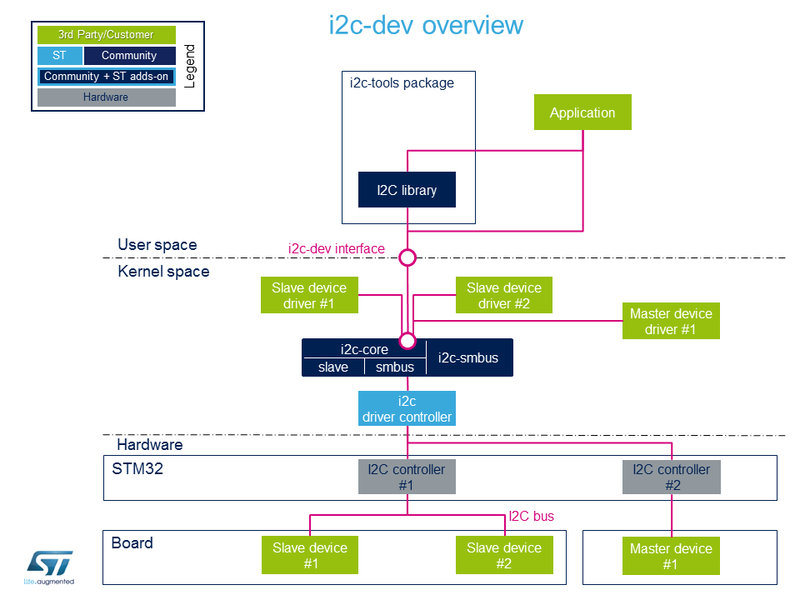
Kernel space driver
允许使用I2C core API开发已编译到内核或作为模块插入的驱动程序[9]
Linux内核提供了有关如何编写I2C客户端驱动程序的示例
[10]
用例 : 使用内核空间内的特定驱动程序控制I2C外设。 例如,驱动程序在系统引导时初始化所有参数,并通过sysfs创建对外围数据的访问。
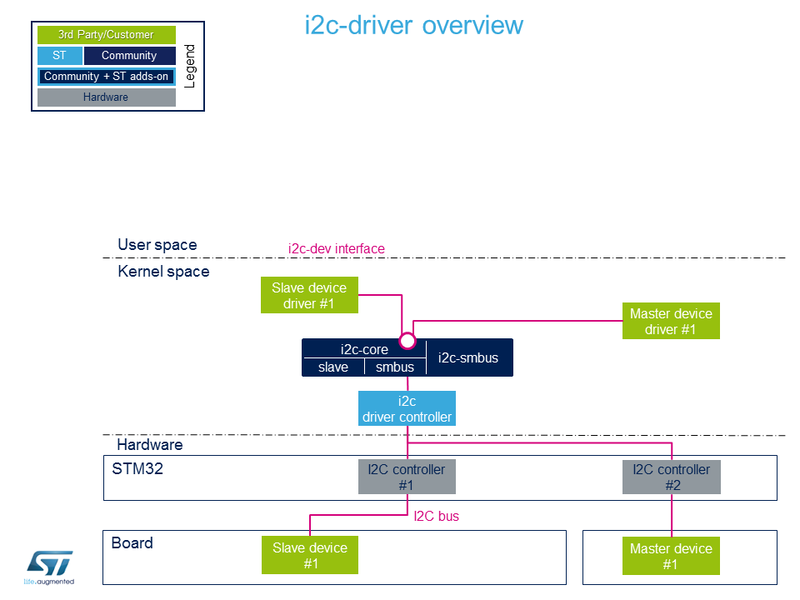
Board description
要实例化外围设备,存在几种方法:更多细节,请参见 实例化设备[11] 。
下列资料主要介绍 device tree, sysfs 和 Application Code.
Device tree
设备树是对内核用来了解连接哪些设备的硬件的描述。为了在I2C总线上添加从设备,请使用与新设备相关的信息来完成设备树。
例子: 带有EEPROM
1 &i2c4 {
2 status = "okay";
3 i2c-scl-rising-time-ns = <185>;
4 i2c-scl-falling-time-ns = <20>;
5
6 dmas = <&mdma1 36 0x0 0x40008 0x0 0x0 0>,
7 <&mdma1 37 0x0 0x40002 0x0 0x0 0>;
8 dma-names = "rx", "tx";
9
10 eeprom@50 {
11 compatible = "at,24c256";
12 pagesize = <64>;
13 reg = <0x50>;
14 };
15 };
EEPROM现在在地址为0x50的总线i2c-X上实例化(X取决于运行时探测的适配器数量),并且它与使用相同属性注册的驱动程序兼容。
请注意,驱动程序指定SCL上升/下降时间作为输入。
有关正确的配置和说明,请参考 I2C device tree configuration。
请注意,I2C规范为特殊目的保留了一系列地址,请参阅 slave addressing[12].
下图显示了设备树及其用法之间的关系:
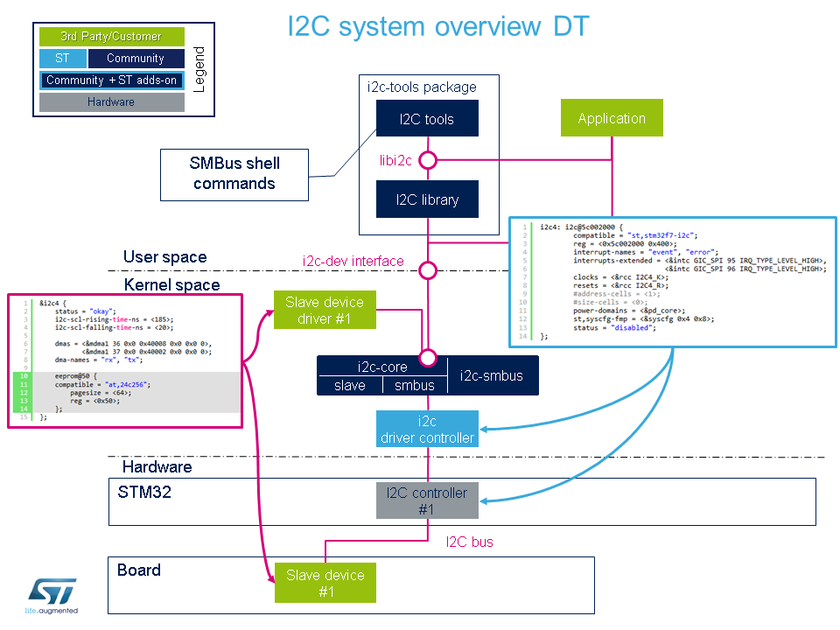
sysfs
通过sysfs,i2c-core提供了实例化和删除外围设备的可能性:
在地址0xAA上添加附加到总线x的外围设备“ myPeripheralName”
注意 字段 "myPeripheralName" 应该与兼容的驱动程序字符串具有相同的名称,以便它们彼此匹配。
echo myPeripheralName 0xAA > i2c-x/new_device
卸下连接到总线x的地址0xAA的外围设备
echo 0xAA > i2c-x/delete_device
进入每个驱动程序目录(/sys/bus/i2c/drivers/at24/ for the EEPROM peripheral example), it is possible to:
将外围设备与驱动器绑定
echo 3-0050 > bind
取消外围设备与驱动程序的绑定
echo 3-0050 > unbind
Application code
这是用于在不使用设备树的情况下将新的从设备注册到I2C适配器的极简代码。
1 #include <linux/i2c.h>
2
3 /* 创建具有从属地址的设备 <0x42> */
4 static struct i2c_board_info stm32_i2c_test_board_info = {
5 I2C_BOARD_INFO("i2c_test07", 0x42);
6 };
7
8 /*
9 跳过模块定义创建
10 */
11
12 static int __init i2c_test_probe(void)
13 {
14 struct i2c_adapter *adap;
15 struct i2c_client *client;
16
17 /* Get I2C controller */
18 adap = i2c_get_adapter(i);
19 /* Build new devices */
20 client = i2c_new_device(adap,&stm32_i2c_test_board_info);
21 }
How to trace and debug the framework
在 Linux® 内核中,有调试和监视I2C的标准方法。调试可以在不同的级别进行:硬件和软件。
How to trace
Dynamic trace
此处提供了详细的动态跟踪 How to use the kernel dynamic debug
Board $> echo "file i2c-* +p" > /sys/kernel/debug/dynamic_debug/control
此命令在运行时启用与I2C内核和驱动程序有关的所有跟踪。
尽管如此,在 Linux® Kernel menu configuration 级,它提供了调试的粒度:核心和/或总线。
Device Drivers ->
[*] I2C support ->
[*] I2C Core debugging messages
[*] I2C Bus debugging messages
- I2C Core debugging messages (CONFIG_I2C_DEBUG_CORE)
Compile I2C engine with DEBUG flag. - I2C Bus debugging messages (CONFIG_I2C_DEBUG_BUS)
Compile I2C drivers with DEBUG flag.
Having both I2C Core and I2C Bus debugging messages is equivalent to using the above dynamic debug command: the dmesg output will be the same.
Bus snooping
Bus snooping is really convenient for viewing I2C protocol and see what has been exchanged between the STM32 and the devices.
As this debug feature uses Ftrace, please refer to the Ftrace article for enabling it.
In order to access to events for I2C bus snooping, the following kernel configuration is necessary:
Kernel hacking ->
[*] Tracers ->
[*] Trace process context switches and events
Depending on the protocol being used, it is necessary to enable i2c and/or smbus tracers as follow:
echo 1 > /sys/kernel/debug/tracing/events/i2c/enable echo 1 > /sys/kernel/debug/tracing/events/smbus/enable
Then tracing is enabled using the following command:
echo 1 > /sys/kernel/debug/tracing/tracing_on
After a transaction, trace can be read by looking at the trace file:
cat /sys/kernel/debug/tracing/trace
Here is part of the output, and how it looks like when using i2cdetect command on the i2c-0 bus:
... smbus_write: i2c-0 a=003 f=0000 c=0 QUICK l=0 [] ... smbus_result: i2c-0 a=003 f=0000 c=0 QUICK wr res=-6 ... smbus_write: i2c-0 a=004 f=0000 c=0 QUICK l=0 [] ... smbus_result: i2c-0 a=004 f=0000 c=0 QUICK wr res=-6
| Notice that i2cdetect, i2cget/i2cput, i2cdump are doing smbus protocol based transactions. |
On the contrary, below output shows the result of a transaction done in I2C protocol mode:
... i2c_write: i2c-1 #0 a=042 f=0000 l=1 [45] ... i2c_result: i2c-1 n=1 ret=1 ... i2c_write: i2c-2 #0 a=020 f=0000 l=1 [45] ... i2c_result: i2c-2 n=1 ret=1
The utilization of traces of I2C bus is well described here I2C bus snooping[13].
How to debug
Detect I2C configuration
sysfs
When a peripheral is instantiated, i2c-core and the kernel export different files through sysfs :
/sys/class/i2c-adapter/i2c-x shows all instantiated I2C buses with 'x' being the I2C bus number.
/sys/bus/i2c/devices lists all instantiated peripherals. For example, there is a directory named 3-0050 that corresponds to the EEPROM peripheral at address 0x50 on bus number 3.
/sys/bus/i2c/drivers lists all instantiated drivers. Directory named at24/ is the driver of EEPROM.
/sys/bus/i2c/devices/3-0050/
/ /
/ /i2c-3/3-0050/
/
/drivers/at24/3-0050/
/sys/class/i2c-adapter/i2c-0/
/i2c-1/
/i2c-2/
/i2c-3/3-0050/
/i2c-4/
/i2c-5/
devfs
If i2c-dev driver is compiled into the kernel, the directory dev contains all I2C bus names numbered i2c-0 to i2c-n.
/dev/i2c-0
/i2c-1
/i2c-2
/i2c-3
/i2c-4
/i2c-n
i2c-tools
Check all I2C instantiated adapters:
Board $>i2cdetect -l
See i2c-tools for full description.
Source code location
- I2C Framework driver is in drivers/i2c drivers/i2c| |}} drivers/i2c drivers/i2c
- I2C STM32 Driver is in drivers/i2c/busses/i2c-stm32f7.c| |}} drivers/i2c/busses/i2c-stm32f7.c
- User API for I2C bus is in include/uapi/linux/i2c.h| |}} include/uapi/linux/i2c.h and I2C dev is include/uapi/linux/i2c-dev.h| |}} include/uapi/linux/i2c-dev.h .
To go further
Bootlin has written a nice walkthrough article: Building a Linux system for the STM32MP1: connecting an I2C sensor[14]
References
- ↑ http://www.i2c-bus.org/
- ↑ https://bootlin.com/doc/training/linux-kernel/
- ↑ Documentation/i2c/slave-interface| |}} Documentation/i2c/slave-interface slave interface description
- ↑ https://www.i2c-bus.org/smbus/
- ↑ https://i2c.wiki.kernel.org/index.php/I2C_Tools
- ↑ Documentation/i2c/summary| |}} Documentation/i2c/summary I2C and SMBus summary
- ↑ 7.07.17.27.3 Documentation/i2c/smbus-protocol| |}} Documentation/i2c/smbus-protocol SMBus protocol summary
- ↑ 8.08.1 Documentation/i2c/dev-interface| |}} Documentation/i2c/dev-interface dev-interface API
- ↑ 9.09.1 https://www.kernel.org/doc/html/latest/driver-api/i2c.html
- ↑ https://www.kernel.org/doc/html/latest/i2c/writing-clients.html
- ↑ Documentation/i2c/instantiating-devices| |}} Documentation/i2c/instantiating-devices How to instantiate I2C devices
- ↑ http://www.totalphase.com/support/articles/200349176-7-bit-8-bit-and-10-bit-I2C-Slave-Addressing Slave addressing
- ↑ https://linuxtv.org/wiki/index.php/Bus_snooping/sniffing#i2c I2C Bus Snooping
- ↑ https://bootlin.com/blog/building-a-linux-system-for-the-stm32mp1-connecting-an-i2c-sensor/